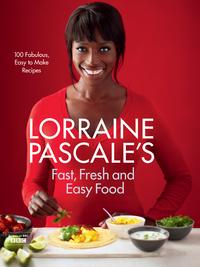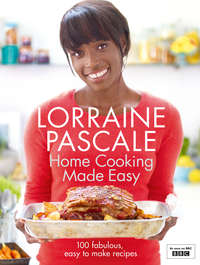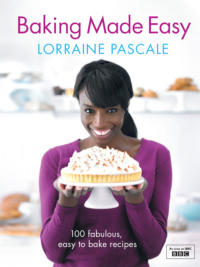
Полная версия
Home Cooking Made Easy
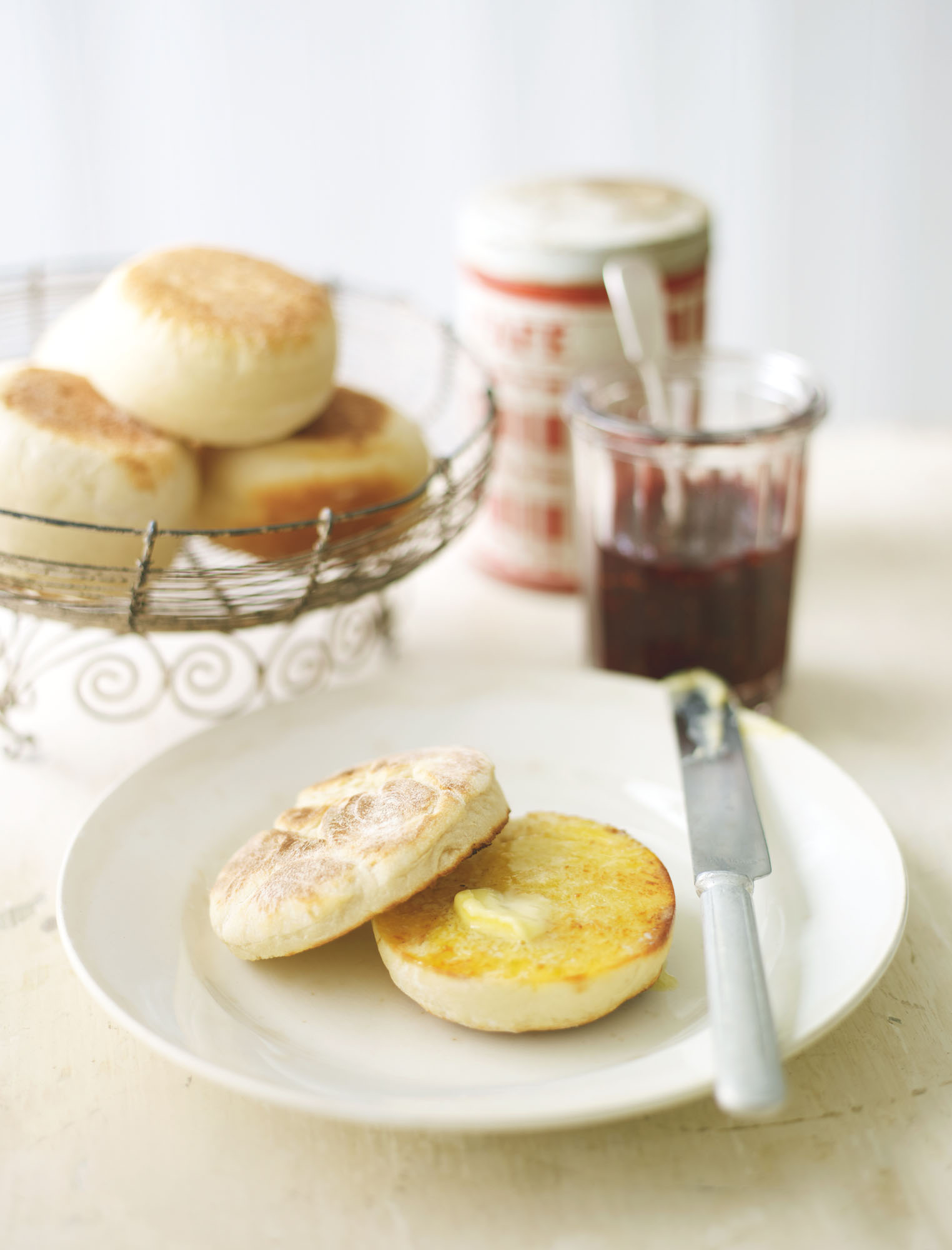
Hamburger baps
I am all for breads with a crunchy crust and am a great advocate of those, but there is also a certain beauty in a soft doughy roll that squidges when lightly pressed. So I embarked on a journey for a soft(ish) roll and found the best way to get one was to use plain flour. If these are cooked for too long, a firm top will result; but if cooked for just the right amount of time, the top will stay soft and squidgy. These baps are great with the salmon and sweet potato fish cakes, or even the lamb and mint burgers. When time permits, I double the ingredients and then pop half the baps into the freezer for another day.
Makes 5 baps (V)
525g plain flour
2 tsp salt
2 tbsp soft light brown sugar
1 x 7g sachet of fast-action dried yeast
150ml warm milk, plus extra for brushing
125–150ml warm water
Sesame seeds
Put the flour, salt, sugar and yeast in bowl. Make a well in the centre and pour in the milk and enough water to make a soft dough. The softer the dough, the better because it will mean the buns will have a really nice rise. Knead the dough for a good 10 minutes if doing by hand and 5 minutes if using a mixer fitted with a dough attachment. To test when the dough is ready, form the dough into a ball so that it has a nice tight top, then using a floured finger, prod it into the dough – if it springs back all the way, then it is ready. Divide the dough into 5 equal portions. Mine weighed 170g each, but this will depend on how much water you have used. Take one portion and shape it into a ball. I like to pull the sides down of the ball down and under so that the top of the bread becomes tight. This makes the bread look really nice when it is cooked.
Now place a dough ball on a baking tray and squash it down a little to flatten it slightly. Repeat with the rest of the dough, placing the dough balls on the tray fairly spaced apart because they will spread during baking. Once all the dough balls are formed, cover them with oiled clingfilm so that it is loose but airtight. I normally have to use several pieces of clingfilm to cover them sufficiently. Leave to rise in a warm place for about 1 hour, or until the dough balls have almost doubled in size.
Preheat the oven to 200°C (400°F), Gas Mark 6. Once the dough balls have risen, carefully remove the clingfilm and brush all over with the extra milk. Sprinkle the sesame seeds over the top. Spray some water into the oven to create a steamy atmosphere. I usually spray 8–10 squirts with a spray gun, then place the baps into the oven. Bake for about 30–35 minutes, or until the baps are golden brown, firm and sound hollow when they are tapped on the bottom. The cooking time will vary according to how much liquid the baps have in them and how long they have been left to rise for.
Once the hamburger baps are cooked, remove them from the oven and leave to cool. These baps are great for burgers, or they can be transformed into iced buns by topping them with icing sugar mixed with a little water.

Puffed-up pitta bread
I LOVE making these! They are so much fun, easy and a real showstopper. These pitta breads have become an absolute firm favourite in my house – wonderful served with curries, dips or soup.
Makes 8 pitta breads (V)
100g wholemeal flour
270g plain flour
1 tsp salt
1 x 7g sachet of fast-action dried yeast
1 squidge of honey
200–250ml water
Oil, for oiling
Put all the ingredients into a bowl except the water and oil and stir for a second to combine. Gradually add the water, mixing with a spoon as you go, until you have a soft dough. I used 220ml, but this can differ with how much water there is in the atmosphere! Put your hands in and take the ball of dough out and knead it for 10 minutes until it is very smooth. To test if the dough is ready, prod a floured finger into the side; if it springs back, then it is ready. If you are doing this in a machine, knead with a dough hook for 5 minutes. Once the dough is kneaded, cover it with oiled clingfilm and leave until it is almost doubled in size. This will take about 1 hour or so.
After about 45 minutes preheat the oven to 200°C (400°F), Gas Mark 6 and put a flat baking tray into the oven to heat up. Divide the dough into eight pieces and roll each one out to about the thickness of a £1 coin, then form into a flattish circular or oval shape slightly thicker in the middle than around the sides.
Spray some water into the oven to create a steamy atmosphere. I usually spray 8–10 squirts with a spray gun, then remove the hot tray from the oven and put four of the pittas on it. Slide the tray back into the oven and cook for about 10 minutes, or until the pittas are nicely puffed up and firm, usually about 7–9 minutes depending the thickness of the pitta. Once they are cooked, remove them from the oven, transfer to a plate and pop in the other four.
Occasionally there are one or two pitta breads that do not want to play puffball, but they should puff up beautifully.
Mrs Stephenson’s dinner party bread rolls
I first made these during my GCSE Home Economics classes at school. Much to the disdain of my highly academic father, I chose Home Economics over History (but he came round to the idea in the end!). While my friends were learning about Henry VIII, I was staring out of the window of the HE block, kneading my dough with a very, very large grin on my face, dizzy with happiness. One of our first assignments was to make shaped bread rolls, glazed old-school style with a heavy eggwash for maximum shine. The daughter of my Home Economics teacher recently got in touch with me, so Mrs Stephenson, thank you, and this one is for you.
Makes 12 rolls (V)
280g strong white bread flour, plus extra for dusting
1 tsp salt
1½ tsp fast-action dried yeast
1 tsp soft light brown sugar
190ml warm water
1 egg, lightly beaten, for the eggwash
3 tbsp sesame or poppy seeds
Put the flour, salt, yeast and sugar in a bowl. Then make a well in the centre and pour in the water. Use a wooden spoon to stir it all together, and when it starts getting stiff, put the spoon down and use your hands to squidge it together into a ball. The dough should feel soft and not too hard – like Blu-Tack. If the dough is too stiff, pop it back into the bowl, add a couple of tablespoons of water and squidge it together with your hands until it comes together. Knead for 10 minutes if doing by hand and for 5 minutes in a machine. Once the dough is kneaded, I weigh it and then divide the number by 12, so all the rolls are an even size.
Roll each one into a ball and either just leave them in a ball or shape them as in the photo. Space the rolls on a large baking tray and cover with oiled clingfilm so it is airtight but not too taut. You may need to use two trays. Leave the rolls in a warm place for about 1 hour, or until they are almost doubled in size.
Preheat the oven to 200°C (400°F), Gas Mark 6. To test the dough, remove the clingfilm and with a floured finger, prod the side of the dough – the dent should spring back halfway. Brush liberally all over with the eggwash and sprinkle with the sesame or poppy seeds.
Spray some water into the oven to create a steamy atmosphere. I usually spray 8–10 squirts with a spray gun, then place the rolls into the oven. Bake for about 15–20 minutes, or until they are golden brown and sound hollow when tapped on the bottom.

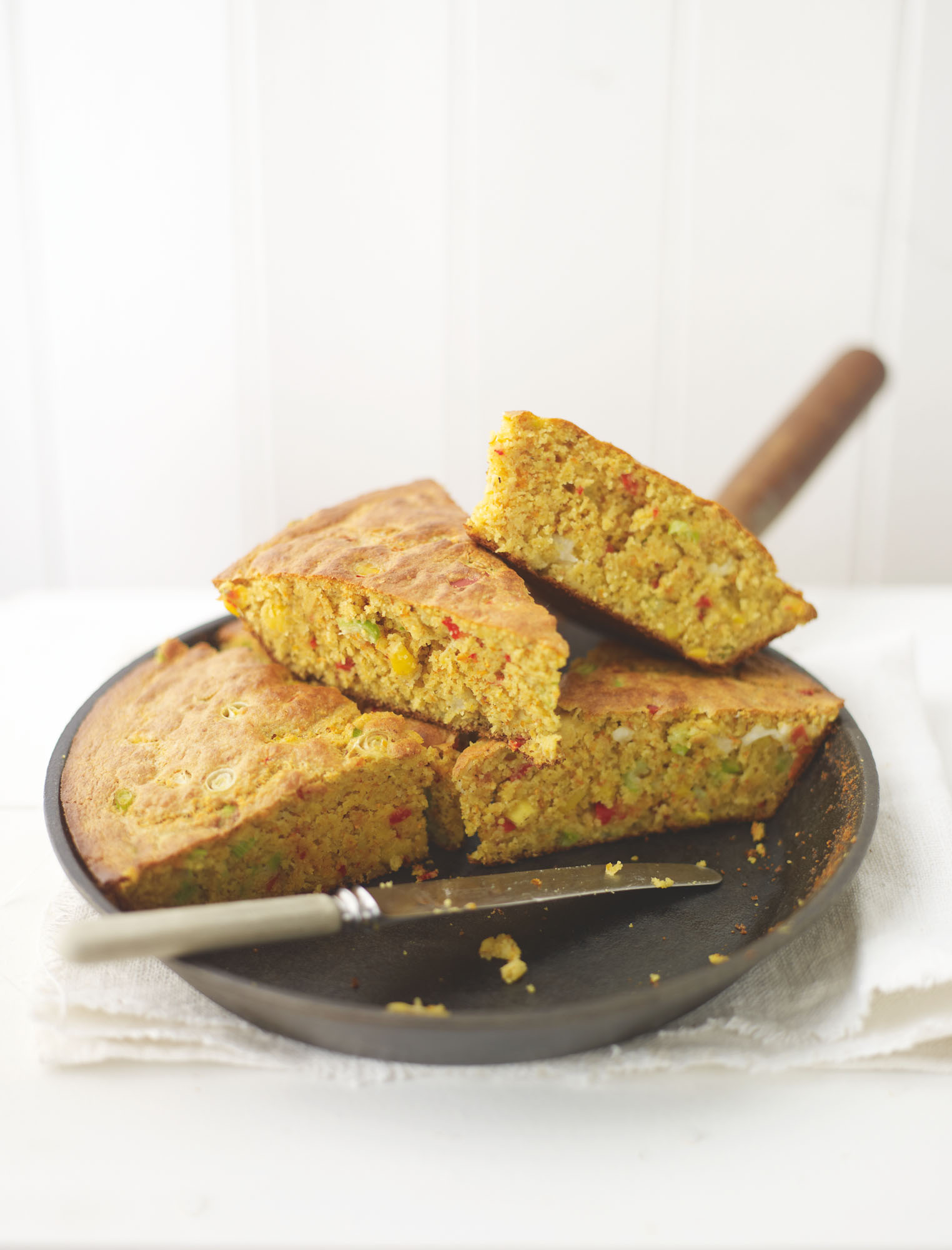
Spring onion & red chilli cornbread
When you want some and you want it quick, an American-style cornbread spiced with chilli and onion is perfect. Use lots of salt and black pepper in the mix, as this bread needs a good amount of seasoning.
Serves 4–5 (V)
Oil, for oiling
220g fine cornmeal or polenta
90g plain flour
1 tsp soft light brown sugar
2 tsp bicarbonate of soda
1 egg
200g natural yoghurt
300ml milk
1 tsp salt
75g tinned drained sweetcorn
30g butter or olive oil
3–4 red chillies, finely chopped
1 bunch of spring onions, trimmed and finely sliced
Salt and freshly ground black pepper
Equipment
Medium ovenproof frying pan, a large brownie tin or a 20cm springform tin
Preheat the oven to 220°C (225°F), Gas Mark 7 and oil the pan or tin. If using the springform tin, line the bottom with baking parchment.
Mix all the ingredients together in a large bowl (the mix will look very sloppy and not that appealing, but I promise it will come good), then place the mixture into the pan or tin. Bake in the oven for about 30 minutes, or until the bread looks cooked and is no longer wet.
Once cooked, remove the bread from the oven, leave to cool, then cut into chunks and eat with a hearty soup.
Really quick ‘Danish pastries’
When I am thinking of ideas for recipe testing, I lock myself in the kitchen with the television on and a huge pile of ingredients and just experiment. About 1 o’clock one Sunday morning, I was standing in the kitchen and staring at a block of puff pastry that had to be used up. I rifled through the cupboards and fridge and found a small tin of apricots and a little tub of ready-made custard. Within a very short space of time, I had conjured up these ‘Danish pastries’ – a more than acceptable alternative to the ‘proper’ ones and with the added satisfaction that they are so quick to make.
Makes 12 small pastries (V)
1 x 375g packet of puff pastry
Plain flour, for dusting
1 x 220g tin of apricot halves
300g thick custard (for these I use shop-bought)
1 egg, lightly beaten, for the eggwash
Sugar, for sprinkling
Preheat the oven to 220°C (425°F), Gas Mark 7. Roll out the pastry on a lightly floured work surface to a square 30cm by 30cm. To make the windmill, or what are sometimes called Imperial stars, cut the pastry into 7.5cm squares and make diagonal cuts from each corner to within 1cm of the centre. Put one or two apricot halves in the centre of the square and spoon over a little ready-made thick vanilla custard, then fold alternate corners of each cut section down to the centre, brushing the tips with beaten egg.
Place them into the fridge for 15 minutes or so until they are firm. Remove them from the fridge, brush them with eggwash and sprinkle with sugar, then place the pastries into the oven. Bake for about 20–25 minutes, or until they are firm, risen and golden brown.
Remove them from the oven and leave to cool.
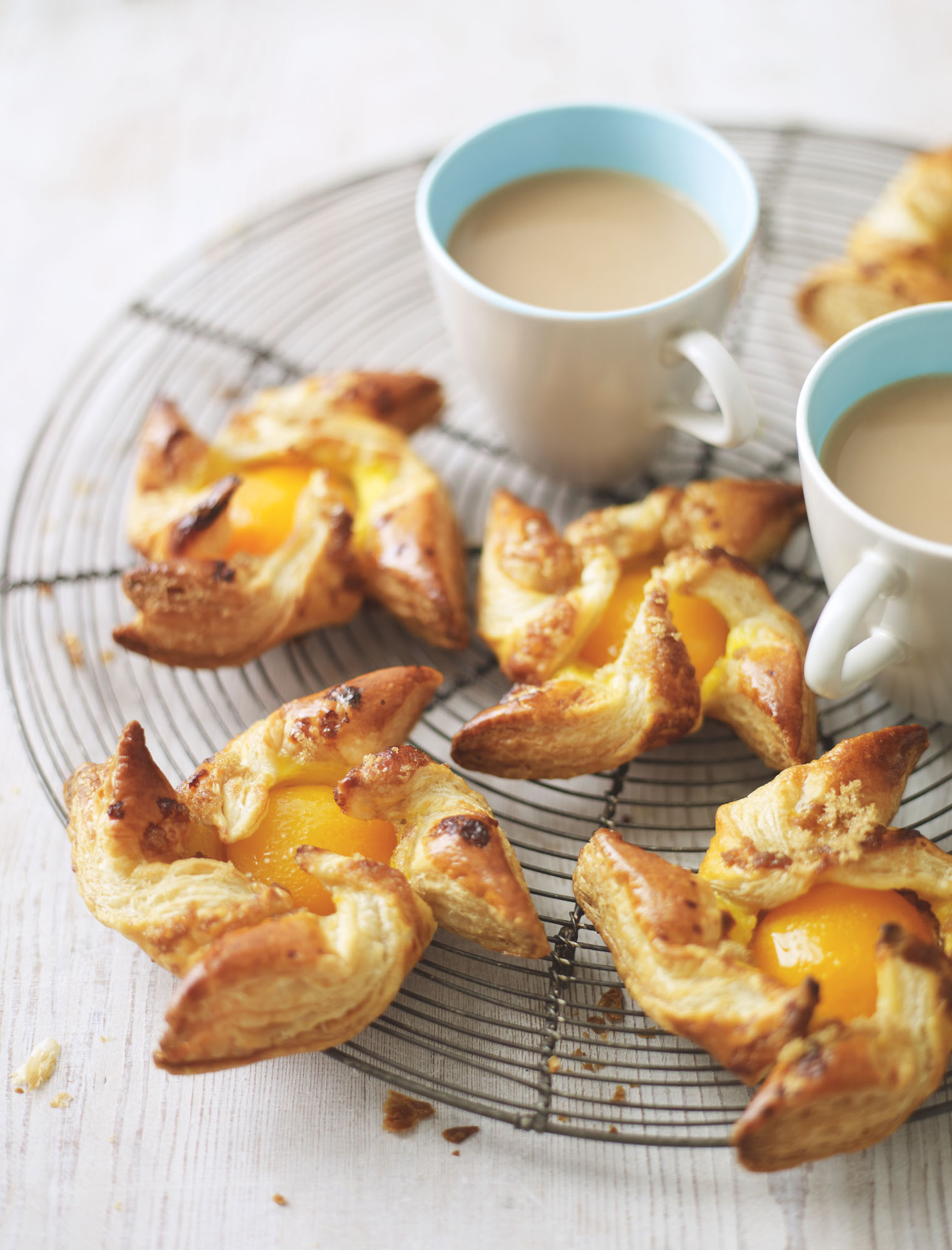
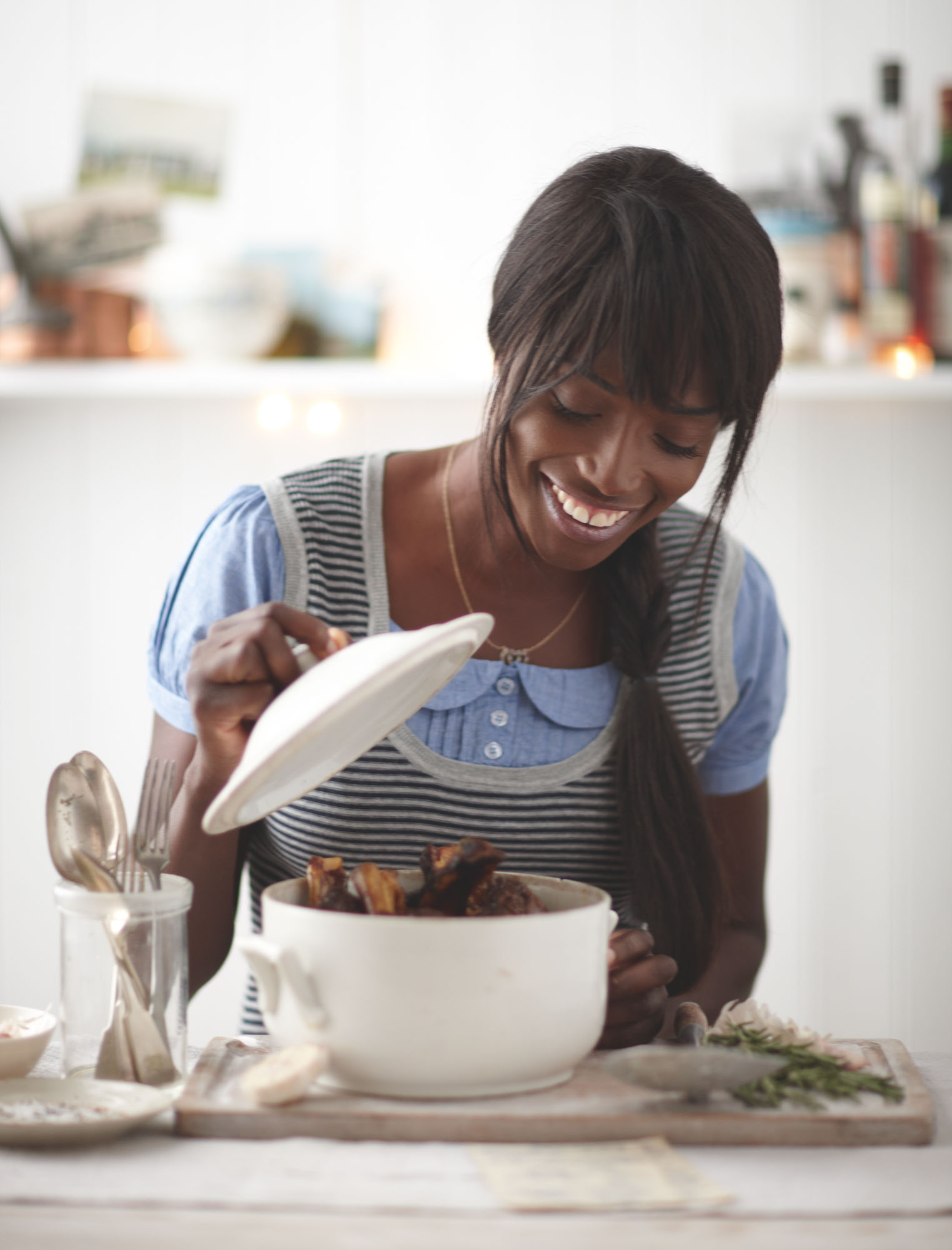
Mains
There is always a question in my mind at the beginning of every day – and that is, what shall I serve for dinner? At the weekends, this also becomes, what shall I serve for lunch? Most days I get in the kitchen and whip up something for the family, but I will wholeheartedly put my hands in the air and say that some days I pop out to the local supermarket and buy something out of a packet to prick with a fork and bung in the oven. So, I wanted to come up with a chapter full of recipes to cook for a main meal, such as super-fast pan-fried lemon sole, to the slightly less quick but very much worth the wait slow-roast pork shoulder with crispy crackling and the very frequently made (in my house) not-so-Cornish pasties. However much time you have, and no matter what the occasion, there is much to choose from here, whether you’re planning a family meal or a smart dinner to impress.
‘An empty belly is the best cook.’
Estonian proverb
Decadent rosemary & Worcestershire sauce shepherd’s pie
This pie is an old-school classic with a hint of something extra.
Serves 4–6
Oil, for cooking
2 medium red onions, peeled and chopped
3–4 tbsp balsamic vinegar
2 carrots, peeled and cut into small cubes
1 stick of celery, trimmed and chopped (optional)
2 sprigs of fresh rosemary, finely chopped
700–750g lamb mince
2 large squidges of tomato purée
3–4 tbsp Worcestershire sauce
200ml Madeira or a good red wine or lamb or beef stock
Salt and freshly ground black pepper
1 bay leaf
Mashed potato
1kg mashing potatoes, peeled and cut into large chunks
70ml single cream
75g butter
Freshly grated nutmeg (optional)
Grated cheese and breadcrumbs, for sprinkling (optional)
Equipment
Medium casserole dish
Piping bag fitted with a star nozzle
Heat some oil in a large pan, add the onions and cook for a few minutes until they are soft. Add the balsamic vinegar, turn up the heat and cook until all the vinegar has evaporated – this adds a little extra flavour. Add the carrots, celery, if using, and rosemary, then stir it all together and cook for a couple of minutes. Add the lamb mince, break it up with a wooden spoon and cook it until the meat has turned from pink to brown.
Preheat the oven to 180°C (350°F), Gas Mark 4. Add the tomato purée, Worcestershire sauce, wine or stock, salt and pepper and the bay leaf and simmer for 30 minutes.
Meanwhile, for the mashed potato, put a large pan of salted water on to boil. Cover with the lid so it comes to the boil faster. Once it is boiling, add the potatoes and cook for 10–20 minutes, or until they are nice and tender and a knife can glide through them easily.
Drain the potatoes, then return them to the pan. Using a potato masher or mouli, mash the potatoes until smooth, then add the cream, butter, salt, pepper and nutmeg, if using, and mix well together. If the mashed potatoes have gone cold, then return the pan to the hob and heat over a medium heat. Make a well in the centre of the potatoes, drop in the butter and wait until it melts, then remove the pan from the heat and add the rest of the ingredients, mixing well. Taste, adjust the seasoning, add more butter if needed, then set aside.
Tip the meat mixture into the casserole dish. If you find that there is too much liquid at this stage, use a slotted spoon to transfer the meat to the casserole dish. This lovely leftover gravy can be used to pour over the shepherd’s pie once it is cooked.
Dollop the mash on top and fork it through to make a pattern. I like to allow the mash to cool a bit, then put it into the piping bag fitted with a star nozzle and pipe the mash on top. Cook the shepherd’s pie in the oven for 20–30 minutes. While not strictly authentic, a large handful each of grated cheese and breadcrumbs sprinkled over the top prior to baking is a delicious optional extra.
Serve with a crispy and crunchy green salad.
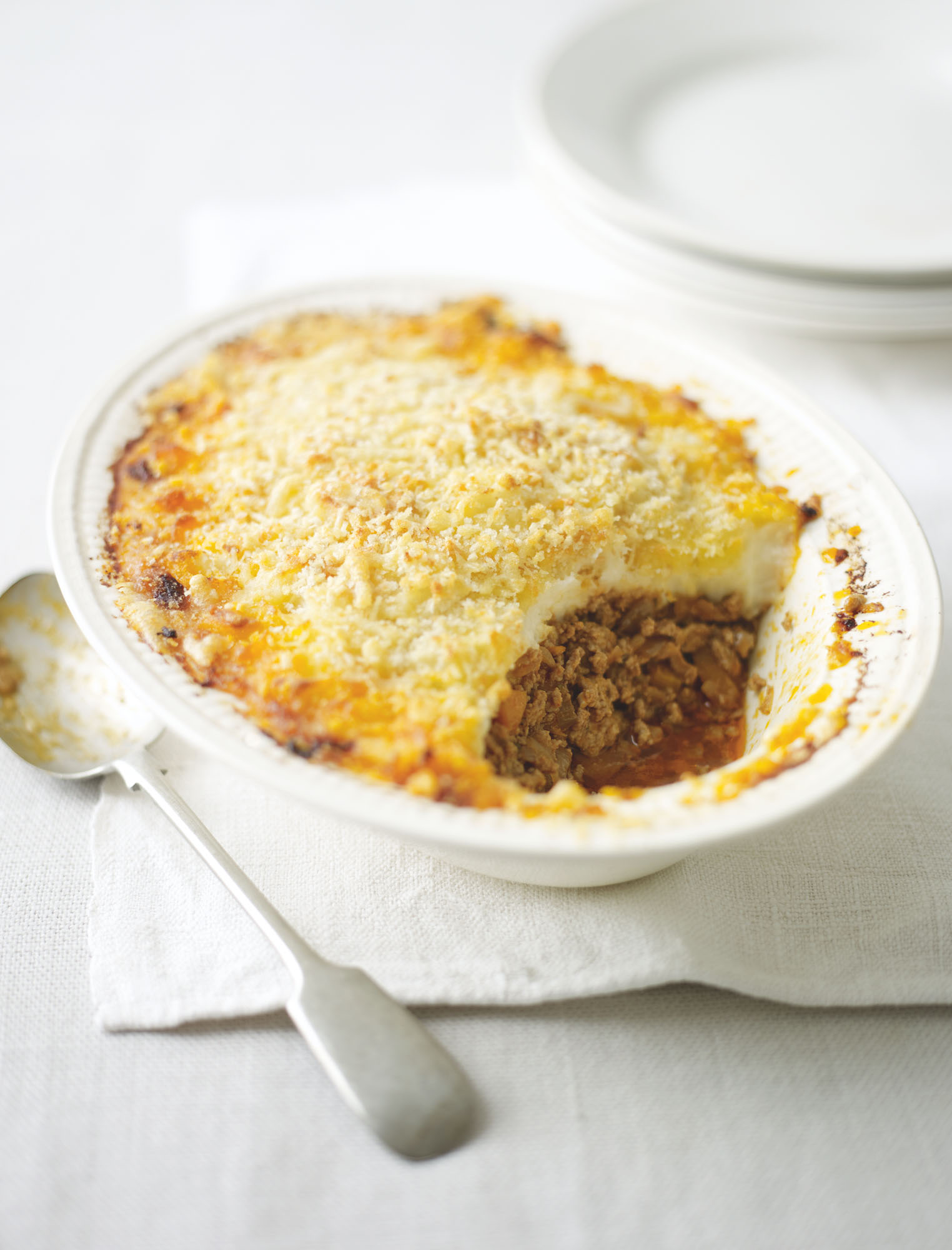
Lemon, tarragon & garlic quick roast chicken with oven-baked potato slices
This is the best way to cook a chicken when time is not on your side; because the chicken is cooked flat it needs less cooking time, so the bird stays beautifully moist.
Serves 4
5 medium potatoes
1 bulb of garlic, unpeeled
Oil, for drizzling and rubbing
Конец ознакомительного фрагмента.
Текст предоставлен ООО «ЛитРес».
Прочитайте эту книгу целиком, купив полную легальную версию на ЛитРес.
Безопасно оплатить книгу можно банковской картой Visa, MasterCard, Maestro, со счета мобильного телефона, с платежного терминала, в салоне МТС или Связной, через PayPal, WebMoney, Яндекс.Деньги, QIWI Кошелек, бонусными картами или другим удобным Вам способом.


